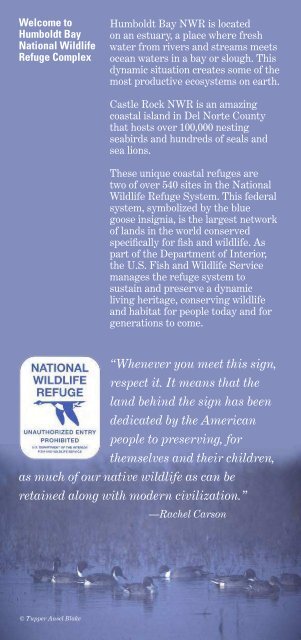Humboldt Bay - U.S. Fish and Wildlife Service
Humboldt Bay - U.S. Fish and Wildlife Service
Humboldt Bay - U.S. Fish and Wildlife Service
Create successful ePaper yourself
Turn your PDF publications into a flip-book with our unique Google optimized e-Paper software.
Welcome to <strong>Humboldt</strong> <strong>Bay</strong> NWR is located<br />
<strong>Humboldt</strong> <strong>Bay</strong> on an estuary, a place where fresh<br />
National <strong>Wildlife</strong> water from rivers <strong>and</strong> streams meets<br />
Refuge Complex ocean waters in a bay or slough. This<br />
dynamic situation creates some of the<br />
most productive ecosystems on earth.<br />
Castle Rock NWR is an amazing<br />
coastal isl<strong>and</strong> in Del Norte County<br />
that hosts over 100,000 nesting<br />
seabirds <strong>and</strong> hundreds of seals <strong>and</strong><br />
sea lions.<br />
These unique coastal refuges are<br />
two of over 540 sites in the National<br />
<strong>Wildlife</strong> Refuge System. This federal<br />
system, symbolized by the blue<br />
goose insignia, is the largest network<br />
of l<strong>and</strong>s in the world conserved<br />
specifcally for fsh <strong>and</strong> wildlife. As<br />
part of the Department of Interior,<br />
the U.S. <strong>Fish</strong> <strong>and</strong> <strong>Wildlife</strong> <strong>Service</strong><br />
manages the refuge system to<br />
sustain <strong>and</strong> preserve a dynamic<br />
living heritage, conserving wildlife<br />
<strong>and</strong> habitat for people today <strong>and</strong> for<br />
generations to come.<br />
“Whenever you meet this sign,<br />
respect it. It means that the<br />
l<strong>and</strong> behind the sign has been<br />
dedicated by the American<br />
people to preserving, for<br />
themselves <strong>and</strong> their children,<br />
as much of our native wildlife as can be<br />
retained along with modern civilization.”<br />
—Rachel Carson<br />
© Tupper Ansel Blake<br />
An International<br />
Flyway<br />
Yukon Delta NWR ✷<br />
✷ Izembek NWR<br />
Grays Harbor NWR<br />
✷<br />
Willapa NWR ✷<br />
<strong>Humboldt</strong><br />
<strong>Bay</strong> NWR ✷<br />
SF <strong>Bay</strong> NWR ✷<br />
San Diego NWR ✷<br />
Did You Know?<br />
More than 50%<br />
of all the brant<br />
in the Pacifc<br />
Flyway stop to<br />
refuel on eelgrass<br />
in <strong>Humboldt</strong><br />
<strong>Bay</strong> between<br />
November <strong>and</strong><br />
May!<br />
© Gary Kramer<br />
The Pacifc Flyway is an “aerial<br />
highway” used by birds that nest<br />
in the far north <strong>and</strong> migrate to<br />
wintering areas in North <strong>and</strong> South<br />
America. <strong>Humboldt</strong> <strong>Bay</strong> <strong>and</strong> many<br />
other refuges are some of the key<br />
“stepping stones” in the Pacifc<br />
Flyway.<br />
The majority of birds use this refuge<br />
as a stop-over where they rest <strong>and</strong><br />
replenish energy reserves. Others<br />
spend the winter here, <strong>and</strong> some use<br />
the refuge for nesting.<br />
The wetl<strong>and</strong>s around <strong>Humboldt</strong> <strong>Bay</strong><br />
are critical to tens of thous<strong>and</strong>s of<br />
shorebirds. This is the northernmost<br />
area on the Pacifc coast where<br />
species such as American avocets,<br />
long-billed curlews, marbled godwits,<br />
<strong>and</strong> willets spend the winter in large<br />
numbers. They can be seen feeding<br />
on the mudfats or acrobatically<br />
skimming over the bay from late July<br />
through April.<br />
<strong>Humboldt</strong> <strong>Bay</strong> is also a key area<br />
for Pacifc brant. These small geese<br />
require eelgrass-flled bays during<br />
their travels between Arctic wetl<strong>and</strong>s<br />
where they nest <strong>and</strong> coastal lagoons<br />
of Baja California <strong>and</strong> mainl<strong>and</strong><br />
Mexico where they overwinter. In<br />
November, most Pacifc brant fy nonstop<br />
from Izembek Lagoon in Alaska<br />
to Mexico in 48-60 hours! On their<br />
return trip from January through<br />
April, as many as 10,000-20,000 brant<br />
may be using <strong>Humboldt</strong> <strong>Bay</strong> at one<br />
time.

















